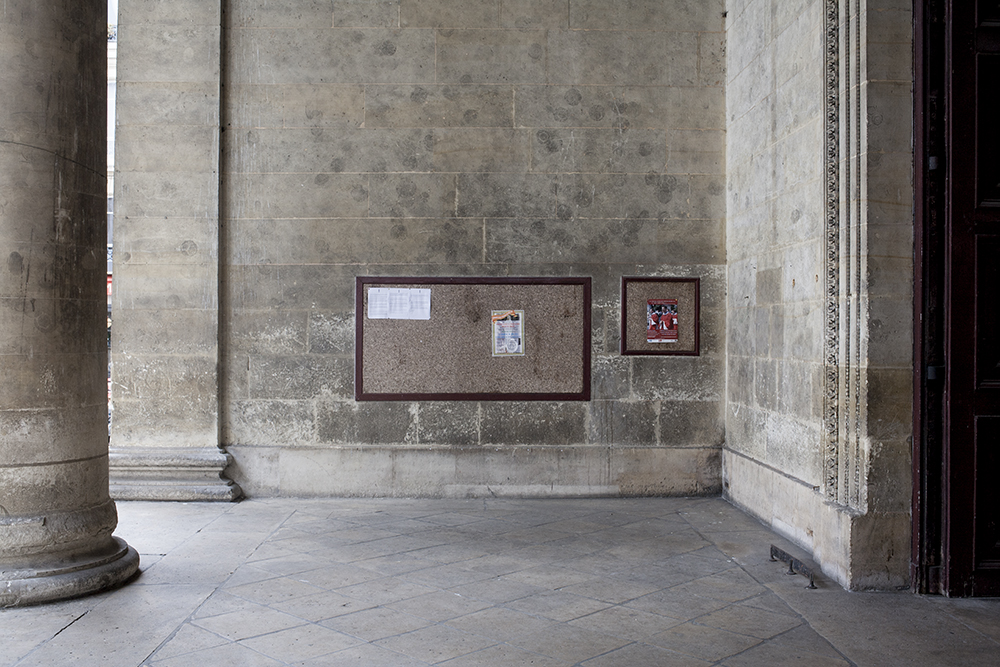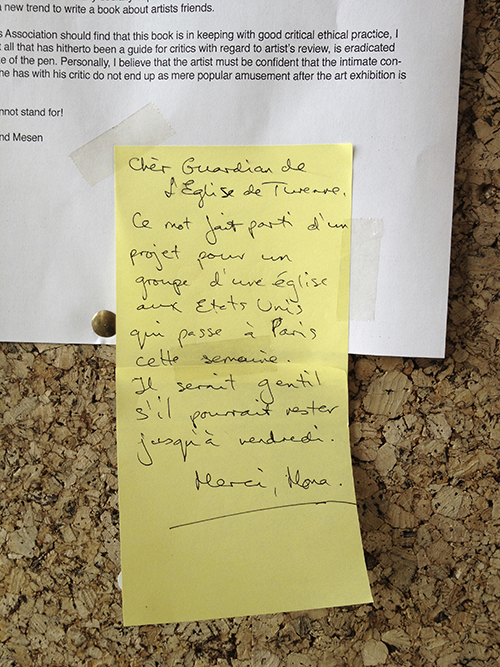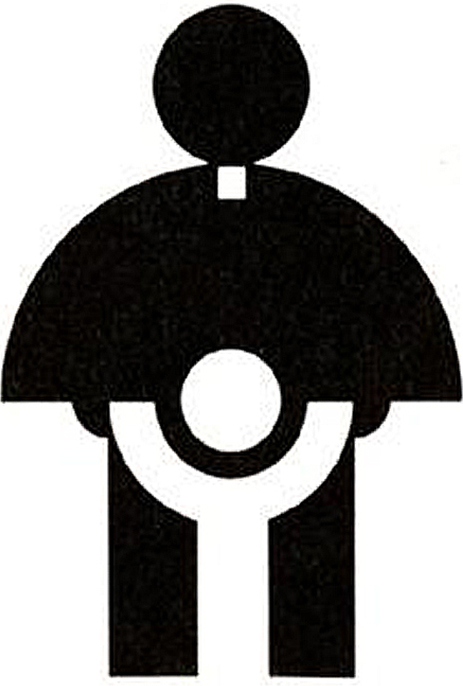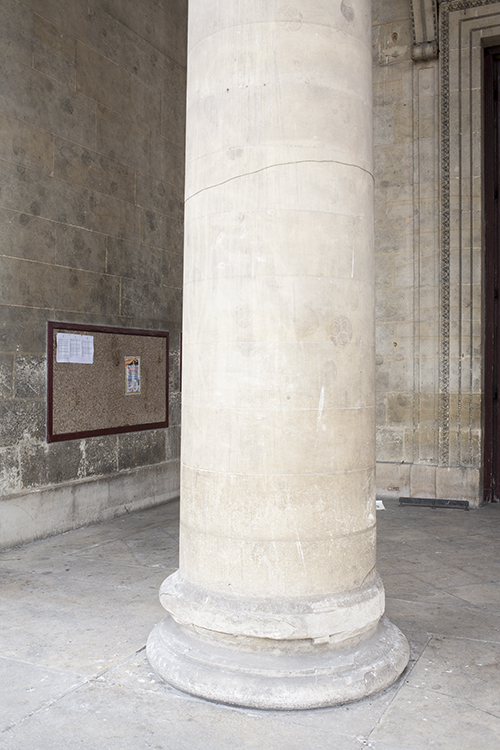Church of Saint-Denys of the Holy Sacrament
68 Rue de Turenne 75003 Paris


The Essay was taken down 4 times by the church.
PPP changed its logo and added a note to complete the week.
Catholic logo seen below.

The Essay
What we cannot stand for this.
Under the heading “Gabrielsen’s argument” The German literary critic Peter Burger comments on the unanimous criticism that has been raised by a number of experienced curators against critic Stian Gabrielsen’s book reviews of his friend, Victor Boullet.
Burger instantly concludes that the critic’s accounts of his own artist does not violate the attorney rules of ethics, and that you must have remarkable powers of observation if you believe otherwise. Equally, you must be living in a dreamworld if you think that part of the book is social pornography.
This is perhaps not surprising, when after reading the book one notes that Burger, already on the book cover himself, has almost quality stamped book’s content by categorizing Gabrielsen as an “honorary award wholesaler” and that this is related to the way he defends Victor Boullet
Burger’s quote is taken from a comment he wrote about Gabrielsen in February. Even though I now probably stand in danger of again being accused of putting forward a “remarkable observation,” there is no doubt that I think that Burger committed to supporting Gabrielsen’s book because he him- self has been used for advertising purposes.
At the expense of the artist’s friend
That Stian Gabrielsen claims that he stands by his book, is something I think the curatorial profession cannot stand. It is a healthy sign that so many curators react after reading the book and Gabrielsen’s own interviews where he claims he has not spoken to his friend since the book was published.
I have never seen a critic distance himself to such a degree from his own artist/friend within inter- views with the press, during the course of a museum exhibition. Based on the seriousness of the show it was of course quite natural and necessary to distance himself from an artistic acts, as well as his friend’s political and ideological standpoint. Gabrielsen however, went a little further - he distanced himself also on a purely human level.
A breach of confidentiality
Hans Ulrich Obrist criticizes Stian Gabrielsen for having written a book about the artist.
Stian Gabrielsen argues in his book that it was very important for him to establish this human distance (p. 51): “I would also later notice, many times, how important it was to establish an additional distance from this artist friend, not only political and ideological but also purely human.“
I think Gabrielsen had great success in this respect. This was of course at the expense of his review of his own artist friend. A friend who had already admitted guilt for the cynicism towards many people and therefore was assured of the strictest art punishment under the assumption that his artistic accountability was known. An artist that, during the time of the show at MOMA, repeatedly called the critics almost wondering where they were.
Why not abstain?

Stian Gabrielsen never had anything positive to say about his artist friend, so why give interviews at all? Was it to satisfy the curators? If you do not have anything positive to say about your own friend, is it not better for the exhibition, to refrain from giving comments?
After Stian Gabrielsen’s description of his friends’s character, together with analysis of his family relationships, there is one word that is suitable beside the obvious ethics violation, namely the review of his own artist friend is also social pornography.
Not me, no!
Stian Gabrielsen poked at Bjarne Melgaard’s self-understanding. This was not graciously received.
By definition, social pornography is precisely the kind of journalism that delivers people up in an intimate way. The term is used particularly to include people who were less likely than others to be able to safeguard their own interests and make wise choices, such as gallerists or curators who are inferior or dependent in some way.
Besides being a close friend and thus dependant on the critic, Gabrielsen claims in his book that to argue with Victor Boullet was like arguing with a child. (p.106).
An art critic has usually, through their status as a critic, already shown that his capability of making the right choices in life are not at their peak. In addition, it is important to understand the affection that artists often feel for their critic. It helps, in my opinion, that the critic can only write books about the artist if the artist were to approve. The artist could easily regret it later. In any event, it cannot be right that a critic who has nothing good to say about his artist writes book about him.
The critic’s ethical rules regarding confidentiality and duty of loyalty is not inversely proportional to the seriousness of the art. A critic cannot think that because he believes that the artist is twisted and lacks empathy (p.53) he can thus come out with the meanest characteristics of the artist.
Everything from strategies and private conversations are exposed and rated.
Stian Gabrielsen makes a huge error when he writes the following in his book (p.48-49):
“The only thing I could think of quickly, that had some similarities with this man and his cold and calculating actions were the worst Nazis in Oslo on Victoria Terrace during World War II, when, with a smile on their face, they gave away their friends to their deaths.”
Stian Gabrielsen must obviously have an ambivalent regard to confidentiality and the duty of loyalty when he also writes (p.138):
“http://boullet.com/6_DEAD_PROJECTS/4_PUBLIC_POLEMIC_PRACTICE_PARIS. and all serious critics should know that you do not go public with details from meetings with artists. “
Contemptuous
The problem is that the book he has written is steeped in just this, namely information from artist’s meetings packed with his own negative characteristics of the artist. Everything from “I do not work for the artist, I work for a system that I am very proud of” (p. 125), to “If only we had seen the artist sitting, grinning and rubbing his hands over what he knew would come.” (p. 162) and further that he “ always felt an inner coldness” in meetings with Victor Boullet.
The contemptuous characteristics that the critic dishes out about his artist will never end. This is just sad reading.
It is not that confidentiality and a sense of loyalty are terminated after the private meetings are over.
Artists should be safe.
Through a very thorough press coverage of Boullet’s show, we’ve all had ample opportunity to follow him and his statements closely. Much of Gabrielsen’s writing is old news, but he goes a long way in disclosing his artist. All of the strategies and private conversations are exposed and evaluated. The critic’s feelings about the artist are very negative and I have trouble understanding what and who this could benefit. The book in my opinion is contrary to the cornerstone of the critic-artist relationship where trust, discretion and loyalty are just as important as the duty of confidentiality.
This book emphasizes the mega critic himself at the artist’s expense.
There will in future also be many socially important curated shows, and I really hope that it is not now becoming a new trend to write a book about artists friends.
If the Critics Association should find that this book is in keeping with good critical ethical practice, I believe that all that has hitherto been a guide for critics with regard to artist’s review, is eradicated with a stroke of the pen. Personally, I believe that the artist must be confident that the intimate conversations he has with his critic do not end up as mere popular amusement after the art exhibition is closed.
This we cannot stand for!
Collector and Mesen Mona
download - Catholic logo pdf
download - PPP logo pdf
